
Nonrefrigerated breakable ice
Several nonrefrigerated breakable model ice
materials exist. Use of the most sophisticated ma-
terials is restricted by proprietary arrangements.
The primary advantage of a nonrefrigerated ma-
terial is that modeling does not require a refriger-
ated facility.
Schultz and Free (1984) describe MOD-ICE, a
proprietary model ice developed by Michel and
acquired by ARCTEC. MOD-ICE is prepared as a
molten mixture of polyethylene powder, polyeth-
ylene beads, heavy vegetable oil, light vegetable
oil, and stearic acid poured onto the water sur-
Figure 13. Beads ice developed by Fleet Technology of
face. Once solidified, the properties remain con-
Canada. (Photo courtesy of Fleet Technology of Canada.)
stant for about three days. The main improve-
ments cited over weakened ices are increased
range of E/σf values (1000 to 3000 even for very
and cubes (or a mixture of large and small parti-
thin ice sheets), better crushing strength simili-
cles) up to 25 mm in diameter into the ice sheet.
tude, and more realistic broken piece size. Since
The sheet properties apparently can be adjusted
the material can be formed in thinner, weaker
by varying the depth of freezing. Very weak ice
sheets, the model scale can thus be increased, re-
sheets could be formed by minor freezing right at
ducing the overall model study cost (Fig. 15).
the surface, and strong ice sheets could be formed
Tryde (1975) describes a model ice material
by extending the frozen depth beyond the thick-
used in a study of the ice breakage pattern in
ness of the spheres or cubes. Some problems in
front of an inclined wedge. The material is cast
the uniformity of the properties were reported
into sheets and includes a combination of plaster
when using the cubes due to the necessity to keep
of Paris, small plastic beads, salt, borax, an air en-
the cube spacing constant. Belyakov reports flex-
trainment agent, and water. Tryde states that the
ural strengths of 25 to 400 kPa measured by the
formula can be altered to vary the material
three point bending test.
strength but that average values give an E/σf of
Fleet Technology of Canada has introduced
500 to 1000.
what it calls "beads ice" (Fig. 13). This weakened
Berdennikov (1974) describes two variations of
ice is produced by freezing a floating layer of
nonrefrigerated model ice material used in hy-
plastic beads on the surface of an EG/AD/S or
draulic model tests where the ice strength was
urea solution (Abdelnour et al. 1993) (Fig. 14).
considered important. The first consisted of
The production rate is increased and control over
keramzit (ceramic/clay construction material)
piece size and density enhanced. No reports of
grains 5 to 10 mm in diameter bonded with a cel-
strengths are given, although mention of possible
luloid glue. This material was cast into molds 1 to
length scale factors of 5 to 50 are made. Fleet also
5 cm thick and upon drying had a strength
found that material handling and bead distribu-
(shear) of 300 to 1000 kPa. The second material
tion prior to freezing are important in providing a
consisted of expanded polystyrol beads 3 to 4 mm
sheet with uniform properties.
Frozen Urea Solution in Pores
Plastic Beads
Figure 14. Cross section of beads ice, showing location
Figure 15. Physical model study using MOD-ICE.
of bead layer.
15



 Previous Page
Previous Page
